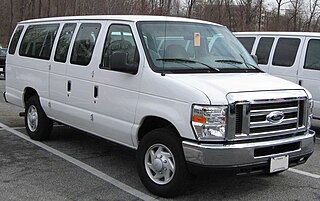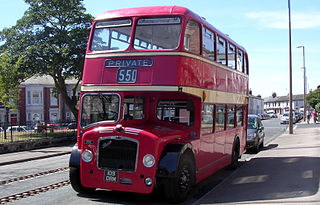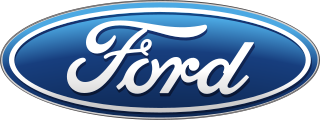
A bus is a road vehicle designed to carry many passengers. Buses can have a capacity as high as 300 passengers. The most common type of bus is the single-deck rigid bus, with larger loads carried by double-decker and articulated buses, and smaller loads carried by midibuses and minibuses; coaches are used for longer-distance services. Many types of buses, such as city transit buses and inter-city coaches, charge a fare. Other types, such as elementary or secondary school buses or shuttle buses within a post-secondary education campus do not charge a fare. In many jurisdictions, bus drivers require a special licence above and beyond a regular driver's licence.

The Ford E series is a range of full-size vans produced by the American automaker Ford since 1960. Introduced for the 1961 model year as the replacement for the Ford F-series panel van, four generations of the model line have been produced. In addition to cargo van and passenger van body styles, the Ford E series has been produced as a cutaway van chassis and stripped chassis.

A minibus, microbus, or minicoach is a passenger carrying motor vehicle that is designed to carry more people than a multi-purpose vehicle or minivan, but fewer people than a full-size bus. In the United Kingdom, the word "minibus" is used to describe any full-sized passenger carrying van. Minibuses have a seating capacity of between 8 and 30 seats. Larger minibuses may be called midibuses. Minibuses are typically front-engined step-entrance vehicles, although low floor minibuses do exist.

The Dennis Dart is a rear-engined single-decker midibus chassis that was introduced by Dennis Specialist Vehicles of Guildford, England in 1989, replacing the Dennis Domino. Initially built as a high-floor design, In 1996 the low-floor second generation Dennis Dart SLF was launched. In 2001, production of the Dart SLF passed to TransBus International, during which time it was sold as the TransBus Dart SLF; Alexander Dennis took over production in 2004, renaming the product as the Alexander Dennis Dart SLF.

The Leyland Titan was a forward-control chassis with a front-mounted engine designed to carry double-decker bus bodywork. It was built mainly for the UK market between 1927 and 1942, and between 1945 and 1969.

The Hyundai RB is a series of rear engine coaches manufactured by the South Korean Hyundai Motor Company.

Cutaway van chassis are used by second stage manufacturers for a wide range of completed motor vehicles. Especially popular in the United States, they are usually based upon incomplete vans made by manufacturers such as FCA US LLC, Ford Motor Company, and General Motors which are generally equipped with heavier components than most of their complete products. To these incomplete vehicles, a second stage manufacturer adds specific equipment and completes the vehicle. Common applications of this type of vehicle design and manufacturing includes small trucks, school buses, recreational vehicles, minibuses, and ambulances. The term "cutaway" can be somewhat of a misnomer in most of the vehicle's context since it refers to truck bodies for heavy-duty commercial-grade applications sharing a common truck chassis.

The Leyland Atlantean is a double-decker bus chassis manufactured by Leyland Motors between 1958 and 1986.

The Bristol Lodekka was a half-cab low-height step-free double-decker bus built by Bristol Commercial Vehicles in England. It was the first production bus design to have no step up from the passenger entrance throughout the lower deck, although Gilford and Leyland Motors had developed low floor city buses in the 1930s, these did not enter production.

The Leyland Leopard was a mid-engined single-decker bus and single-decker coach chassis manufactured by Leyland between 1959 and 1982.

Charles H Roe was a Yorkshire coachbuilding company. It was for most of its life based at Crossgates Carriage Works, in Leeds.

Barton Transport was a bus company that operated in Nottinghamshire from 1908 until 1989.

The Daimler Fleetline is a rear-engined double-decker bus chassis which was built between 1960 and 1983.

Bus manufacturing, a sector of the automotive industry, manufactures buses and coaches.
Gibson's of Moffat was a bus and coach operator in Dumfries & Galloway, Scotland. It is no longer in business.
H. V. Burlingham was a British coachbuilding business based in Blackpool, Lancashire from 1928 until 1960 when they were taken over by London-based rivals Duple Motor Bodies. Duple initially renamed Burlingham as Duple (Northern) but in 1969 they closed their Hendon factory and concentrated production in Blackpool. Duple coach bodies were built in the former Burlingham premises until Duple itself was liquidated in 1989.

The Bristol LH was a single-decker bus chassis built by Bristol Commercial Vehicles (BCV) in Bristol, England. Nearly 2,000 were built between 1967 and 1982 in a variety of sizes and body types, including some as goods vehicles.
The Leyland Royal Tiger PSU was an underfloor-engined bus and coach chassis manufactured by Leyland between 1950 and 1954.





















